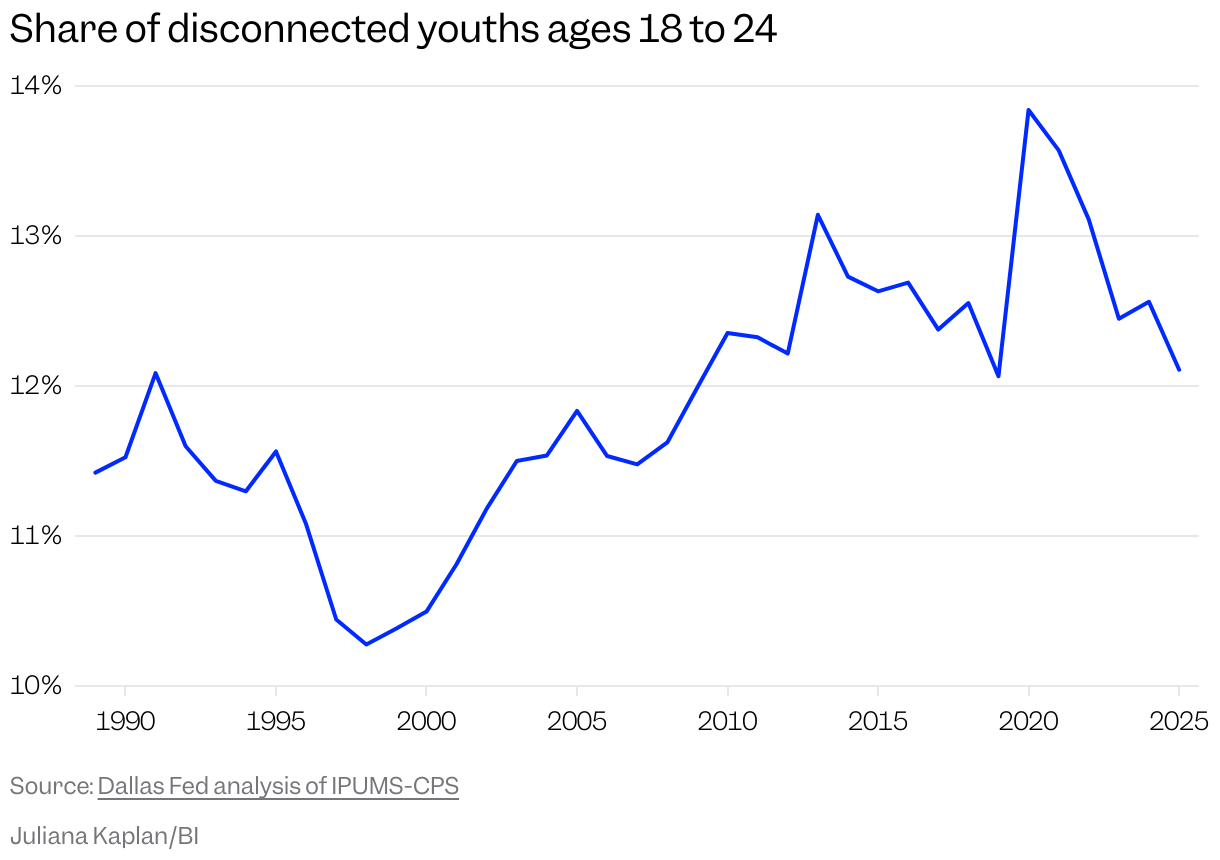
Getty Images; Alyssa Powell/BI
- They’re young, don’t have degrees, and have given up on work.
- The rise in disconnected youth has a mix of economic and cultural explanations.
- Some young people believe they could land a job, but are still choosing not to seek employment.
Why aren’t some Gen Zers looking for work? It’s a growing mystery of the American economy.
In recent decades, the share of 22- to 27-year-olds without a college degree who are working or seeking employment has dropped, per a Goldman Sachs analysis of US government data, published in July. That group saw a steeper decline in labor force participation than their counterparts with college degrees.
While some of them aren’t seeking employment because they’re still enrolled in school, there are other more troubling factors in the equation.
Over the past 30 years, the share who say they’re “unable to work” for reasons other than school, childcare, disability, illness, or retirement has doubled to nearly 5%, per Goldman Sachs, compared with under 1% for college graduates.
It’s another sign of a disconcerting rise in disconnected youth — young Americans who are not in school, not working, and not looking for work. According to data from the Federal Reserve Bank of Dallas, the share of disconnected 18- to 24-year-olds has fluctuated in recent decades but trended upward. The roughly 12% of disconnected youth, as of the latest May data, was higher than in any year between 1989 and 2009.

Workforce experts told Business Insider that the answer to this labor market mystery — what’s preventing many young Americans from seeking employment — lies in a mix of economic, cultural, and psychological forces.
Have you struggled to find work or stopped looking altogether? If you’re open to sharing your story, please fill out this quick Google form or contact this reporter at [email protected]. You can also find more of our job market coverage below:
- A former Microsoft worker has been job-hunting for 9 months. He says it feels like companies are ‘looking for Superman.’
- I applied to over 500 jobs but couldn’t find a full-time job for 8 months. This networking strategy helped me finally get one.
- The milestone that divides Gen Z’s career fortunes
- Job searching in 2025? It’s a mess no matter how old you are.
Some young people don’t want the jobs that are available to them
One theory for why young people without degrees aren’t looking for work is that they don’t want the jobs that are available to them, said Zachary Mabel, director of research at Georgetown University’s Center on Education and the Workforce.
According to his analysis, the share of young non-graduates who report being out of the labor force because they couldn’t find work has held steady from the early 2000s through the first quarter of 2024 — aside from spikes during the Great Recession and the pandemic — even as overall participation for the group has trended downward.
“It suggests that the uptick that we’re seeing is among people who can find work, but are choosing not to seek employment in the jobs that they have access to,” Mabel said. “So it’s not that they’re not employable — it’s that they are choosing not to work in the jobs for which they are employable.”
If the inability to find a job isn’t driving the decline in labor force participation, that points to a different set of factors — a black box of reasons that don’t include disability, illness, retirement, childcare, school, or the inability to find work.
Mental health challenges and a bias against certain roles
Some young people without degrees are choosing not to work available jobs because they don’t think they pay enough to be worthwhile, said Carol Graham, senior fellow in economic studies at the Brookings Institution.
“They have a mindset of, ‘My friends who work are miserable, you don’t get benefits, you’re not going to be able to afford things anyway, so why bother?'” she said.
Mabel said that jobs offering “family-sustaining earnings” have become increasingly concentrated among degree holders, which could be deterring some young people from pursuing employment.
He added that he believes a “cultural bias” has developed over time against many jobs that don’t require a degree, discouraging some young people from pursuing blue-collar roles that could support them financially.
“We’ve created sort of a stigma against going into these professions,” he said. “It’s one of the reasons we see massive shortages in the skilled trades, for example, even though many of those jobs do in fact pay quite well.”
Young people’s perceptions of jobs aren’t the only thing keeping them out of the workforce. Graham said rising rates of mental health struggles in recent decades have prevented some from pursuing work.
She said young men are particularly vulnerable — often isolated, lacking a sense of purpose or connection, and in some cases battling drugs or alcohol.
“They become kind of ‘non-people,'” she said. “They’re not looking for a job, they’re not part of anything, they’ve lost their narrative for life.”
Family assistance and gig work
Some struggling young people are being supported by their families. Mabel said the pathway to adulthood has lengthened in recent decades, with more young people living at home and relying on financial help from relatives.
“It’s taking a lot longer for younger cohorts than previous generations to become financially stable and to live independently,” he said.
If young people can lean on family support and don’t see job options that would allow them to strike out on their own, Mabel said, many may decide not to work at all.
The rise of the gig economy could also be skewing labor force data. Mabel said that some young people working as freelancers for platforms like Uber or DoorDash might not consider themselves formally employed when surveyed, partly due to the flexible nature of gig work. If they answer “no” when asked whether they’re working or looking for work, they won’t show up in official labor force statistics. While the evidence for this phenomenon is mixed, Mabel said it could be one factor driving down labor force participation rates.
“We may be missing a bunch of people who actually are working, but doing so in a part-time gig role, and are just not being captured in the data as participating in the labor force,” Mabel said.
Potential solutions
Graham pointed to education models that embed practical work experience, such as high school and community college programs with internships or apprenticeships, which can give students a clearer path into stable jobs.
Mabel argued that reducing the stigma around jobs that don’t require a college degree — through campaigns or early education — could make trades and other non-degree paths more appealing.
“We’re not going to be changing the mind of a 30-year-old today,” he said, “but we might change the mind of a 10-year-old so that when they are 20 or 30, they might have a different conception of what an attractive career pathway is than the previous generation or two did.”
It was a sentiment shared by both experts: there’s hope for the young people of tomorrow, but helping those who need it now will unfortunately be an uphill battle.
“It’s not a lost cause,” Graham said. “But it’s in some ways a lost cause for the older ones that are already 25 or 30.”
Read the original article on Business Insider
The post Why America’s disconnected youth are growing — and how to fix it appeared first on Business Insider.




